Atlantic Monthly Contributors's Blog, page 216
March 6, 2016
House of Cards Season 4, Episode 12: The Live-Binge Review
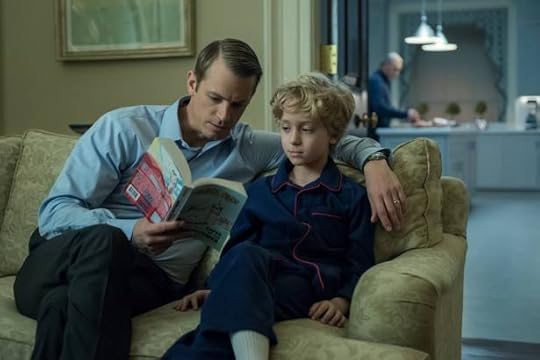
As in previous years, I’m binge-reviewing the latest season of Netflix’s House of Cards, the TV show that helped popularize the idea of “binge watching” when it premiered in 2013. Don’t read farther than you’ve watched.
(Previously: Episodes 1, 2, 3, 4, 5, 6, 7, 8, 9, 10, 11)
Episode 12 (Chapter 51)
Stipulated: This show is ridiculous. It’s best not to think of the levels of coincidence that were required to bring the Republican presidential nominee and his family into an overnight stay with the sitting Democratic president. Like the Underwoods themselves, House of Cards’s writers believe that ends always justify means. The ends, in this case, were some electrifying scenes of Frank conversing with Will, Claire conversing with Hannah, and radiant little brats running all over the frigid museum that is the Underwoods’ domestic life. In their kitchen showdown, Frank managed to deliver Will a punishing ego check, but note his phrasing: He said that if Conway wins, he’ll be revealed as a fraud. Which means Frank agrees with what Yates said—Will is too smart to slip up and lose his momentum. He really could win.
Terrorism has finally been put on the list of hot topics that Cards deals with. But unlike with some past ripped-from-the-headlines plots, there’s a profound disconnect between reality and fiction. In our world, ISIS has been a barbarous spectacle for years. Meanwhile, the world of Cards, it seems, is not one that is acclimated to beheading videos and hostage situations. It’s a world that is slightly less numb than ours. To be sure, the fact that the kidnapping and extortion threat on this show happens in America, to a random family, pulled off by Americans, makes it a uniquely horrifying spectacle. But the captors’ request to speak to Conway also contributes to it feeling less real, more a plot contrivance than a terrifying fable.
Then again, the scenes of war-room negotiations with the terrorists were as tense as anything the show has served up. And I can’t wait to read the fact checks on the forensic domestic surveillance methods on display, like when the FBI isolated bird songs deep in the background of a phone call and used it to figure out the caller’s region. The episode’s cliffhanger suggests that the season will end with the most horrifying demonstration yet of just how big a risk Frank is willing to take in the name of political gain. Those gains may be for naught, though, since Garrett Walker took time from his guitar collecting to talk to Hammerschmidt.

How Has the MFA Changed the Contemporary Novel?
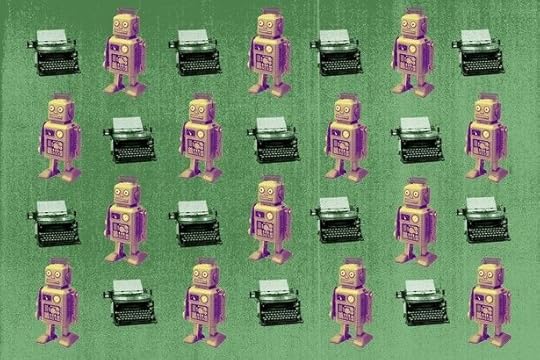
This year, about 20,000 people applied to study creative writing at MFA programs in the U.S. It’s a funny fact to consider, given that the idea creativity could be taught used to be widely mocked—the literary scholar John Aldridge once said the programs produced “clonal fabrications of writers.” For a time, MFA programs were oddities on college campuses: In 1975, only 52 existed. Much of this has changed in the last two decades. Today, there are more than 350 creative writing programs in the U.S. alone, and that number doubles if you include undergraduate degree programs.
The rise of the MFA has changed how both writers and people in general talk about creativity. The debate has shifted from whether creativity could be taught to how well it can be taught and whether it should be taught. The stakes are real: Creative writing has become a big business—it’s estimated that it currently contributes more than $200 million a year in revenue to universities in the U.S.
Today’s debate falls along predictable fault-lines: One side eyes the teaching of writing suspiciously, and concludes that MFA programs may produce some good fiction, but they don’t produce enough “great literature.” The other side defends the institution by saying, if nothing else, that programs give aspiring writers the time to “dedicate oneself” to the craft of writing. But there’s an underlying assumption that the MFA does something. There’s a widespread belief that if you get an MFA, at the very least, it will change your writing in some discernible way.
But what if there’s no change to speak of? Is it really possible to tell the difference between novels that have been through the meat-grinder of the MFA and those that haven’t? What if this is just something that’s been imagined into existence, by both detractors and supporters alike, to satisfy a collective need to believe that institutions can improve anything, even creativity? Or conversely, that institutions ruin everything, especially creativity? Whether you valorize the Romantic ideal of the lonely, humble artist or the neo-liberal belief that education can solve any problem, the MFA has become a kind of Rorschach test for how writers and critics feel about creativity, where it comes from, and how best to nurture it.
Until now, no one has used much evidence beyond the anecdotal to test whether or not the MFA has actually influenced the contemporary novel. What if this debate, furious as it is, is just a distraction from more important questions surrounding creative writing, like problems of diversity within publishing or financial exploitation on the part of universities?
We’re two professors of language and literature who regularly use computation to test common assumptions about culture. So we decided to examine to what extent writing from MFA graduates differs from writing by non-graduates. We collected a sample of 200 novels written by graduates of MFA programs from over 20 leading programs (including Columbia, University of Texas at Austin, Iowa, and others) that have been published in the last 15 years. (This sample includes authors like Rick Moody, Alix Ohlin, and Ben Lerner.) For the sake of comparison, we also collected a similarly sized group of novels published over the same time period by authors who haven’t earned an MFA degree (including writers like Donna Tartt, Miranda July, and Akhil Sharma). To make these two groups as comparable as possible, we only gathered novels by non-MFA writers that were reviewed in The New York Times, which we took as a mark of literary excellence. Using a variety of tools from the field of computational text analysis, we studied how similar authors were across a range of literary aspects, including diction, style, theme, setting, and even how writers use characters.
Needless to say, novels consist of much more than just these features. What makes a single novel a great novel, what makes, say, Junot Diaz sound like Junot Diaz, is of course mostly immeasurable. But these features remain the fundamental building blocks of any novel, so if MFA writing were in aggregate to have some essential difference from books written by authors without MFAs, it should be perceptible at the very least at this genetic level of prose. There has to be something that makes them different, and those differences, according to the vigor and tenacity of critics’ claims, ought to be recognizable. As Mark McGurl, the author of the sweeping history of the MFA, The Program Era, writes, creative writing programs “obviously” teach writers how to become a specific “creative type.” Or as Chad Harbach has argued more recently in his popular essay “MFA vs. NYC,” “the university now rivals, if it hasn’t surpassed, New York as the economic center of the literary fiction world.” If there are indeed “two literary cultures” in Harbach’s words, we should be able to detect it.
MFA novels tend to focus more on lawns, lakes, counters, stomachs, and wrists. They prefer names like Ruth, Pete, Bobby, Charlotte, and Pearl.
We began by looking at writers’ diction: whether the words used by MFA writers are noticeably different than those of their non-MFA counterparts. Using a process known as machine learning, we first taught a computer to recognize the words that are unique to each of our groups and then asked it to guess whether a novel (that it hasn’t seen before) was written by someone with an MFA. When we did this, the computer was successful only about 67 percent of the time at guessing correctly. You don’t need a degree in statistics to know this isn’t very good—you can be right 50 percent of the time just by accident. To put this number in context, with the same procedure we can predict bestselling novels about 82 percent of the time or whether a novel is a mystery or romance 85 percent and 95 percent of the time, respectively.
Nevertheless, there are some words that are different, but given that we’re talking about over 200,000 unique words, this is hardly surprising. For example, MFA novels tend to focus more on lawns, lakes, counters, stomachs, and wrists. They prefer names like Ruth, Pete, Bobby, Charlotte, and Pearl (while non-MFA novels seem to like Anna, Tom, John, and Bill). But on the whole, these distinctions look pretty meaningless; the words that appear more often in MFA novels don’t seem to be related to each other in a significant way. To test whether this was the case, we used a method called topic modeling that examines themes instead of individual words. And while MFA novels do tend to slightly favor certain themes like “family” or “home,” overall there’s no predictable way these topics appear with any regularity in novels written by creative writing graduates more than other people who write novels. To sum up: So far, no real difference between MFA and non-MFA works.
How about style? Surely, we thought, there should be some stylistic differences between these novels. The way writers put their words in order, that special MFA voice, should be detectable at some level. As one brochure has it, the goal of the adjunct faculty of an MFA program is to “work closely with their students to help them develop their own voices, styles, and form.” Presumably upon graduation those voices should be discernibly different than what’s already out there on the market. However, taking syntax as a measure of style—if we see style as the way writers sequence their words, the way they put their sentences together—we saw little difference between the two groups. MFA novels tend to use pairs of adjectives or adverbs less often, or avoid the more straightforward structure of a noun followed by a verb in the present tense. But other than that, there’s nothing detectably unique about the so-called “MFA style.”
So far, nothing. No real distinctions at the level of language, themes, or even syntax. When we went further to test whether the way writers constructed their characters was any different, once again nothing significant showed up. It was extremely difficult to separate the MFA and non-MFA writing groups in any meaningful way. If these results seem unbelievable, we shared this feeling as we carried out our tests. Our starting point was that there must be some mark of distinction. Why else were critics like Elif Batuman saying things like “the creative writing program has exercised the single most determining influence on postwar American literary production”? Why else were people paying for these schools?
Only 7 percent of MFA graduates are fully funded, which means 93 percent are investing some portion of their money to sound like everyone else.
Contrary to the critics, many top MFA programs explicitly state that they’re “doctrine free” and allow students to develop their writing “on their own terms.” They do not, they claim, actively try to make their students sound any particular way. As the University of Texas program says, “The best thing we do for fiction writers at the Michener Center for Writers is leave them alone.” But then why go? If a program isn’t going to train you or change you in any significant way—and the data suggest that by and large most don’t—then the costs of that investment start to seem deeply questionable. According to the latest research, only 7 percent of MFA graduates are fully funded, which means 93 percent are investing some portion of their own money to sound like everyone else.
Some might say that’s precisely the point. The MFA isn’t about developing a unique style at all, but about learning how to sound like already published writers. It’s about gaining entrance to the club. Look closely at the promotional materials of creative-writing programs and you’ll almost invariably see a host of proper names—these are the people with whom you can expect to rub shoulders, if not directly, then by association through the former graduates that have passed through the program or the mentors of your mentors whose influence will surely rub off on you. It’s about having the opportunity to insert yourself, however virtually, into that literary social network.
But this absence of distinction also has its hidden costs. Things begin to cut more deeply, for example, when we look at issues of gender or race. A major claim of the MFA is that it not only helps an aspiring writer find his or her voice, but it particularly helps minority writers discover some authentic self through the process of writing. As McGurl has shown, “find your voice” was a mantra at Iowa in the 1960s, and starting in the 1970s, it took on particular significance for writers of color. Programs like Iowa trumpet their success in training writers like Margaret Walker and Sandra Cisneros.
But when we refined our tests to look at how race factors into the results, we found the opposite to be true. We took each separate body of work—books by MFA writers and books by non-MFA writers—and compared all of the writers in each individual corpus along the metrics of diction, style, and theme we describe above. For both corpora, we expected white and non-white writers to group together in clusters, and we anticipated that non-white writers would especially group together in the MFA corpus (authors like Tayari Jones, Chieh Chieng, and Daniel Alarcon). But we found no such thing. Again, based on diction, theme, and syntax, these two groups, in both MFA and non-MFA writing, are impossible to distinguish.
96 percent of the MFA novels we sampled have a majority of male characters.
The MFA promises to make the distinction of race come alive, take on literary heft, through learning how to write and the work of writing. But we have no evidence that MFA authors are any better at this than their less educated non-MFA peers. If there’s a quality that distinguishes a writer as Asian American or black, we could not find it. Junot Diaz has argued that MFA programs are “too white” and reproduce the “dominant culture’s blind spots and assumptions about race and racism.” It’s a claim that fits in with our algorithm’s inability to tell apart works by non-white writers and white writers.
But this erasure of voice gets an even more negative spin when we look at gender. A second major claim of the MFA is that getting an education in writing is an enlightening experience, and a key part of this enlightenment we can assume is learning how to challenge society’s gender norms. Many MFA programs, like the universities they are a part of, say they actively promote a culture of challenging “patriarchy” and “heteronormativity.” Cornell’s MFA program, for instance, celebrates the gender diversity of its faculty, which is “evenly split” between men and women. We’d expect MFA writing to actively resist gender stereotypes, especially given that MFA graduates skew overwhelmingly female (about 66 percent of MFA grads are women, which is about 10 percentage points higher than for the master’s degree more generally).
Once again, the data tell a different story. The percentage of male protagonists in novels written by MFA grads is well over half, at 61 percent, while that figure is 65 percent for non-MFA novels. Further, if a novel has a female lead, the chances that it has two strong female characters is only 32 percent for both MFA and non-MFA novels. Last, the percentage of novels that have a majority of male characters in the non-MFA group is 99 percent, whereas it is 96 percent for MFA novels. These are terrible numbers by any standard. They suggest that the contemporary American novel is disproportionately preoccupied with the experiences of men. And they suggest that the MFA novel is only barely better than its non-MFA counterparts. It’s possible that MFA writers have found more subtle ways to create strong female characters that go beyond simple numerical representation. But the raw numbers are damning: MFA writers are no better at representing women, and both groups are downright bad at it.
These results are hard to square with the increasingly amplified discourse that surrounds the MFA, whether for and against. While something may happen in MFA programs, perhaps that thing is more behavioral than artistic. When we look at the data, the MFA seems to be helping people sound like everyone else. To put a positive spin on it, we could say the degrees help writers fit into the literary landscape. Like the universities to which these programs belong, the MFA may offer a way of gaining entrance to an elite club. You learn the rules of the road, at least as defined by the publishing industry and literary reviews. At its worst, it doesn’t do anything at all.
The intensity with which readers and critics feel and think about the MFA, we might assume, has become disconnected from its moderate-to-minimal effects on the literary landscape in America. So it seems to us that the MFA doesn’t merit many of the hyperbolic claims about its impact on literature. $200 million per year, after all, is a high price to pay for very little measurable impact.

House of Cards Season 4, Episode 11: The Live-Binge Review
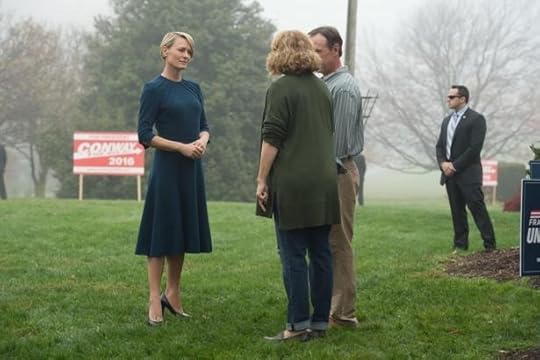
As in previous years, I’m binge-reviewing the latest season of Netflix’s House of Cards, the TV show that helped popularize the idea of “binge watching” when it premiered in 2013. Don’t read farther than you’ve watched.
(Previously: Episodes 1, 2, 3, 4, 5, 6, 7, 8, 9, 10)
Episode 11 (Chapter 50)
Despite the Underwoods’ formidability, it’s never been clear how good they are at doing the thing that politicians are supposed to do: convincing people to vote for them. With Frank stranded in D.C. thanks to a health scare, Claire spends this hour searching for a way to connect with the electorate, but it’s a struggle. Tom Yates helps her comes up with a solution, and in typical Yates fashion, it’s a pseudo-profound abstraction: “beyond marriage.” In telling us that this is effective messaging, Cards becomes like, say, TV shows or movies about musical geniuses, where you just have to suspend disbelief that the mediocre original song that the producers commissioned would really sweep the nation.
But the underlying principle of the episode is inarguable: Human connection matters. Claire’s affair with Tom is the result of pure yearning, and Frank recognizes her need for affection to be real and serious enough to sanction their canoodling—even when it results in awkward breakfasts at the White House residence. Stamper, in a fittingly queasy-making plot turn, seems to pursue a romance with the very woman widowed by his own efforts. The fact that he now has something to live for besides his job for should have concrete effects on that job, maybe to Frank’s detriment.
It may, in the end, be the Underwoods’ disregard for human fellowship that sinks them. Remy, a former ally spurned by betrayal and sickened by Frank and Claire’s tactics, has begun talking to Hammerschmidt (though in one small bit of good news for Frank, it appears the journalist is only pursuing him for political crimes, not murder). General Brockhart has been lured to the campaign of Conway, who remains impervious to Frank’s overtures regarding ICO. And most shockingly of all, Freddy explodes at Frank, having endured enough false warmth from him to last a lifetime. Note that the folksily condescending way Frank at first was talking to his old friend and ribmaster sounds a lot like the way that Frank talks on the campaign trail, or when he’s lying to someone’s face. People are starting to see through the shtick.
Read the review of the next episode.

March 5, 2016
House of Cards Season 4, Episode 10: The Live-Binge Review
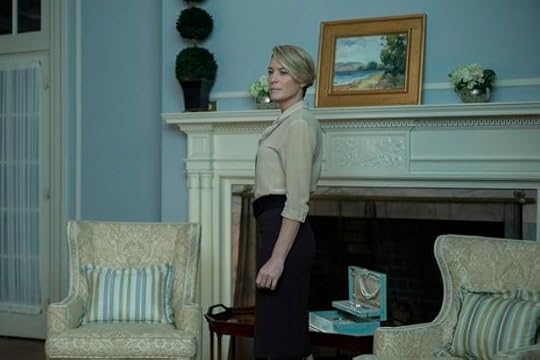
As in previous years, I’m binge-reviewing the latest season of Netflix’s House of Cards, the TV show that helped popularize the idea of “binge watching” when it premiered in 2013. Don’t read farther than you’ve watched.
(Previously: Episodes 1, 2, 3, 4, 5, 6, 7, 8, 9)
Episode 10 (Chapter 49)
“I don’t use national-security matters for political purposes,” Frank says to the press scrum, and viewers are supposed to snort. He has of course used national-security matters for political purposes time and again, and is now doing it more drastically than ever by modulating his decision-making on ICO and wiretapping the American public in pursuit of votes. House of Cards is in large part about how for the Underwoods and for many of their peers, there is nothing that can’t be brought into the political arena. Perhaps that’s because nothing really exists outside of the political arena anyways. Even death.
Claire resists her mother’s request for assisted suicide, at first. But then Elizabeth argues that her dying will help Claire politically. On one level: Wow, that’s messed up. On another, it’s a touching indication of Elizabeth wanting to reconcile and help her daughter after so many decades of clashing with her. On another, it’s a demonstration of Claire’s moral lineage—no wonder she is the way she is. And on yet another, it’s simply a statement of the obvious. Elizabeth’s death was going to matter to the election regardless of whether she and Claire acknowledged that fact. The issue was simply how much of an effect it would have, which in turn was an issue of timing. Elizabeth certainly would have applauded as Claire then fabricated an entire deathbed conversation for a national audience the next day.
Watching Elizabeth go was wrenching, in part because it happened at the hand of her daughter and in part because Ellen Burstyn had done such an incredible job conveying the lifetime of sadness and struggle that had preceded that moment. Of course, Cards will allow no moment of genuine human feeling to go by without profaning it somehow, and so Claire and Tom then abscond upstairs to have sex. Or maybe seeing this as profane is too square: A yearning for love has been reawakened in Claire, no doubt, and Frank certainly isn’t going to fulfill it.
It’s fitting that the Underwoods would realize their insane dream of running together only by taking advantage of death. Death has long been a tool in their arsenal, and Frank accessed that fact in this episode in a way that we hadn’t seen before: by alluding to his murderous past as an intimidation tactic. Yes, he immediately said he was just joking about Lucas’s accusations being true, but everything else about his Oval Office interaction with Cathy—the letter opener, the blithe statement that he would have killed people had it had been necessary—amounted to a death threat. She fell in line. Permanently? Unclear. The move he just pulled was very risky.
Death also suffused the other plot lines this hour. Hammerschmidt is pulling at threads that could reveal Frank’s killings. Stamper is struggling with the thwarting of his once-unquestioned control of Underwood’s underlings, with even his violence against Seth not being enough to hold him in line. That stress combined with the guilt of having cost an innocent man a liver has gotten to him, to the point where he made the seemingly ill-advised move to donate to the dead man’s family without hiding his name. The questions that action could bring about may not take down Frank—he wasn’t in on breaking organ-transplant rules, obviously—but they could bring down Stamper.

House of Cards Season 4, Episode 9: The Live-Binge Review
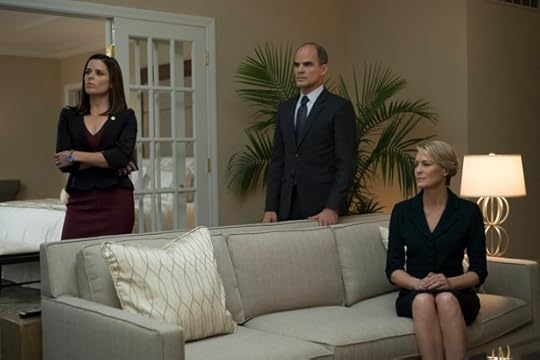
As in previous years, I’m binge-reviewing the latest season of Netflix’s House of Cards, the TV show that helped popularize the idea of “binge watching” when it premiered in 2013. Don’t read farther than you’ve watched.
(Previously: Episodes 1, 2, 3, 4, 5, 6, 7, 8)
Episode 9 (Chapter 48)
Potential good news for real-life news networks in 2016: Open political conventions make for great TV. The insanity of multiple ballots, grandstanding state delegates, and the fact it seems like anyone can vote for anyone indeed does elevate what otherwise is, in the words of a Van Jones on CNN-Cards, a “four day infomercial.” But if the Republicans go through all of this in a few months, it will be quite a bit different, one imagines: For one thing, Melania Trump can’t run for VP without sending her husband’s birther fans into fits.
Someone should catalog the various types of political schemes that the Underwoods have attempted over the course of this show. We’ve seen the one that they pulled on Cathy Durant here—where they profess to work with someone while secretly working against them—a few times. It’s amusing and unsettling to watch unfold, given that it involves so much blatant lying to various peoples’ faces. Cathy, to her and the show’s credit, recognizes the ploy as the very one that landed her as Secretary of State. She turns it back on Frank by emulating the maneuver he and Doris Jones used to undermine Claire earlier this season: by suddenly making a pass to the other team.
Conway receives that pass ably while also staging a table-turning press event about Islamic terrorism. Frank notes that this ploy’s a lot like one he’d pull, and their buddy-buddy interactions during their closed-door chat underscores just how alike they really might be (and should turn some viewers on to the mobile game Agar.io). Except: Conway is younger, more technologically savvy, has served in the military, has an adorable family, and hasn’t been tainted by scandal. Last episode, it was asserted that the Underwoods’ advantage was their ruthlessness—but what if this guy is just as morally flexible?
Read the review of the next episode.

House of Cards Season 4, Episode 8: The Live-Binge Review

As in previous years, I’m binge-reviewing the latest season of Netflix’s House of Cards, the TV show that helped popularize the idea of “binge watching” when it premiered in 2013. Don’t read farther than you’ve watched.
(Previously: Episodes 1, 2, 3, 4, 5, 6, 7)
Episode 8 (Chapter 47)
No one was asking for the return of Tom Yates, a certified phony whose writing, one hopes, is meant only to be a parody of false depth and not the show’s attempt to offer the real thing. Both Frank and Claire have an inexplicable attraction to him, but they have the pretense of realpolitik reasons—blocking his book from coming out—to hire him as a speechwriter. He, meanwhile, chooses not to sell out the Underwoods because he wants to find a new ending to his novel inspired by them. Get ready for more shots of people looking out windows as Paul Sparks mumbles on about clouds and ghosts and sunsets as metaphors for whatever is happening in the plot.
It’s enough to make you miss the astringency of Zoe Barnes, whose ghost haunts this show more than ever. Tom Hammerschmidt’s investigation has kicked off what feels like the beginning of House of Cards closing its own loop, circling back to people and sets we haven’t seen since 2013. I’m not sure what the point of the phone call with her DUI dad was other than to make her into an even more tragic figure in the afterlife and to remind us of one of the most gut-churning depictions of Father’s Day ever. But Hammerschmidt’s visit to her old block (DC folks, where do we think she lived? Petworth?) turned out to be pivotal because it confirmed that the journalist was onto something. It also showed that dumb luck is sometimes essential to an investigation: Meechum’s image was on TV at the exact right moment.
The Underwood’s machinations with a VP pick and a gun-control bill purposefully sunk by the NRA were, perhaps, not the easiest thing to follow. And it’s not clear to me why Cathy Durant wasn’t in the running from the start if she’s such an acceptable candidate to all involved. But the backroom dealing did give the chance the for the show’s creators to smirkily serve up another all-too-relevant exchange: “A Supreme Court confirmation in the middle of the election?” “Grow a pair.” The prospect of a brokered convention may also turn out to be prescient if the #NeverTrump crowd gets its way in real life. In Cards land, you can guess at why Frank pushed for chaos in the convention hall: He can manipulate it so that it seems like there’s an authentic groundswell for Claire to be his running mate.
She, of course, is helping that effort by taking an ever more visible role in the policy arena. Her robo-call speech on gun control again demonstrated how her political ruthlessness can dovetail with her personal magnetism and sense for when and how to feign vulnerability. The show has suggested that Frank has a formidable match in Will Conway, but I wonder if Claire does too in Hannah. She played hardball with the Vanity Fair editor, but she also authentically swooned over Tom Yates's breakout (and fraudulent) novel, while her husband sneered that its main character was a “pussy.” I wasn’t sure of what to make of that moment. It certainly doesn’t remind me of Claire and Frank.
Read the review of the next episode.

Blackflix and Zoe Saldana as Nina Simone: The Week in Pop-Culture Writing

Blackflix
April Joyner | Marie Claire
“Just because I’m black—and even though I am keen to support black filmmakers—doesn’t mean every single movie or show I watch needs to feature black actors or be about ‘black stories.’ There are plenty of reasons I might want to watch Beyond the Lights.”
Zoe Saldana as Nina Simone Is What Happens When Diversity Doesn’t
Damon Young | Very Smart Brothas
“Much of Simone’s work was specifically centered in her specific experience as a dark-skinned black woman who existed outside of America’s—white America’s and, sadly, black America’s—general standard of what’s considered beautiful. Zoe Saldana, on the other hand, doesn’t just exist within the standard. For many, she is the standard.”
The Weight of James Arthur Baldwin
Rachel Kaadzi Ghansah | Buzzfeed
“Baldwin’s people have an old-world, sophisticated manner. They offer you three types of tea, whiskey, and their time. They’re patient and generous. They never ask me what I’m doing there. They are tolerant of my desire to find the quiet bibliography that he left behind in the small notations, brushes, and ephemera of his life.”
On Poverty
Alison Stine | Kenyon Review
“Making art is more than a leisure activity exclusively for the well-off. For some, including the poor, it’s a calling that cannot be denied. There is no stronger motivation than that. There is no brighter fire. There are other voices beyond professors. Other kinds of lives, other struggles that are real, vividly imagined, and deserving of time.”
How I Learned to Stop Worrying and Get in Formation
Vann R. Newkirk | Seven Scribes
“Who says I can’t be fierce; that I can’t embrace the same kind of joyous, jubilant, dancing celebration of myself as her fans do? Who says that my journey to the Joy, that capital-letter rebellion of embracing freedom and liberation, has to be done through the cold, rigid lens of hypermasculinity? While some things may not resonate as deeply with me because my own struggles are already highlighted in our media, who says Beyoncé can’t be my musical liberator of choice?”
Letter of Recommendation: Vanderpump Rules
Naomi Fry | The New York Times Magazine
“I’d rather poke out my own eye with a stick than participate in a so-called opting out. But thinking of stasis as one possibility among others—even if just for limited periods of time, even if just in the sense of loosening the hectoring voice in your own head that urges you to always keep marching forward—seems a culturally viable, emotionally necessary option.”
Joe Cool
Alicia Eler | The New Inquiry
“But Joe doesn’t need to be your ‘friend’ online. He doesn’t want a Tinderized relationship. Trader Joe’s is counting on capturing successive generations of its target consumers by being the choice for no-choices, the place where generic brands can feel exclusive. You’ll know without having to be told. You’ll buy without ever wondering if you’ve made the wrong choice.”
Passport out of Regent Park: Mo-G on Life, Death, and Drake
Safy-Hallan Farah | MTV News
“We’ve seen many rappers come before him—just as eccentric and dynamic—but their stars tend to dim and fade out. Perhaps what sets Mo-G apart is all his grief, all his heart. He tells of the night he wrote ‘Mind Symphony’, and this crystalline moment around all of it. The uncertainty and fatedness of it all goes hand-in-hand for him—life, death, success, fame, the sacred and the profane.”
These Journalists Dedicated Their Lives to Telling Other People’s Stories. What Happens When No One Wants to Print Their Words Anymore?
Dale Maharidge | The Nation
“Many have changed careers and are doing well enough—on paper. Talk to them, however, and many say they miss the newsroom. Others soldier on, freelancing in a market of falling rates. Some drive for Uber; others lurch into early retirement, wondering if they’ll make it. Journalists often seek an emblematic person to illustrate a story. But sometimes there’s no single through-line character. Sometimes there are 22,000 of them.”
Brewers’ David Denson Hopes Coming out Paves Way to Achieving MLB Dream
Scott Miller | Bleacher Report
“Behind him are the shadows from which he emerged to declare himself to the world, finally brave and comfortable enough in his own skin to do something that no other active, affiliated professional baseball player ever has dared. Ahead are skies that have cleared for the first time in his memory, the dawn of an era that finally will allow him to continue pursuing a very old dream in a very new way.”

March 4, 2016
House of Cards Season 4, Episode 7: The Live-Binge Review

As in previous years, I’m binge-reviewing the latest season of Netflix’s House of Cards, the TV show that helped popularize the idea of “binge watching” when it premiered in 2013. Don’t read farther than you’ve watched.
(Previously: Episodes 1, 2, 3, 4, 5, 6)
Episode 7 (Chapter 46)
You could call this Chapter 46 or you could call it the start of House of Cards season 4.5. The arc of the previous six episodes, centered mostly on the struggle between Claire and Frank, has drawn to a conclusion for now (and Frank’s almost fully recovered from his life-or-death ordeal, with the only permanent effect seeming to be a head of grey hairs). Instead of carrying over the storylines and tensions that accompanied it, we get a fresh slate of ‘em, and the result feels like a whole new show. Or like an old one. Frank’s back to addressing the camera on a regular basis. The frequent cross-cutting from director Tom Shankland feels like it’s out of a Steven Soderbergh film. I’m not complaining: There was a lightness to the hour as it embraced trashy fun rather than high melodrama, and the conflict it sets up is a good one.
The Conways are a fiction so tantalizing that you wonder why the real political parties haven’t served up something like them already. Will is a particularly charming incarnation of the film/TV trope of a young handsome veteran governing a state from across the ideological aisle. But the gimmick of his family curating their life on a publicly accessible cell-phone camera is a plausible bit of marketing genius. It’s also totally ghastly: a reminder that social media has turned us all into politicians and valorized vanity (did you catch the Conways watching themselves in the mirror as they had sex?), not to mention the ease with which it turns children into props. How many episodes before the Underwoods plant a dirty photo in their stream? One?
Or maybe the Underwoods will come up with a plan that’s yet more devious, generated by a working relationship that’s stronger than ever. When Frank was mansplaining the need for steely guts toward the start of the episode, I worried that the peace they’d established would turn out to be fragile. But throughout the hour, we saw them support and improve each other in concrete ways, most obviously by rehearsing negotiations with the NRA lobbyists and congressional leadership.
The NSA plotline seems a bit ridiculous; you can practically hear the screenwriters brainstorming ways to work in hot-button issues like domestic surveillance and ISIS into the story and then hitting upon a way to join the two. Whatever. The scene where Frank imagined a duel with Conway in front of the portraits of his predecessors was classic Cards fun, and while it seemed for a bit that he was waffling about wiretapping for ethical reasons, the real reasons for him to pause, it later became clearer, are the political and legal risks. As Claire points out, though, their one advantage over everyone else is that they’ll go farther than anyone else to get elected. It’s significant that for the first time, though, Frank has wondered aloud whether this particular step might be too far.

Would You Buy a Pre-Peeled Orange?
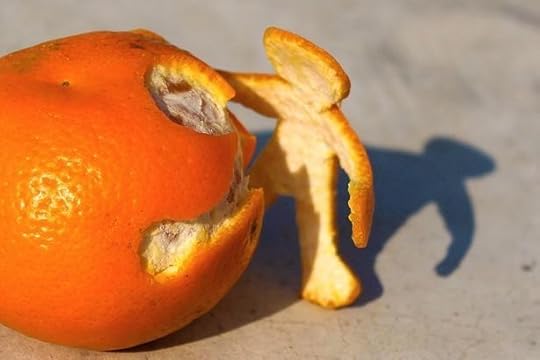
This time, it was oranges. Nathalie Gordon, shopping in a Whole Foods on Thursday, came across an unusual item in the pre-packaged foods section of the store: a series of oranges, encased in plastic boxes, that the store was selling pre-peeled.
She tweeted about her find:
If only nature would find a way to cover these oranges so we didn't need to waste so much plastic on them. pic.twitter.com/00YECaHB4D
— Nathalie Gordon (@awlilnatty) March 3, 2016
The tweet, unsurprisingly, went viral. There are, after all, so many things to object to here: the excess packaging dedicated to a food that, as Gordon pointed out, already comes nicely pre-packaged by nature. The suggestion that peeling an orange is just so much work. The Marx-would-squirm labor—implied, but unseen—involved for the people who did that work on the behalf of Whole Foods’s patrons. The boxes’ nonsensical MADE RIGHT HERE labels. The Buffalo Bill-y creepiness of the oranges, stripped of their skins, left with only meager bits of pulp to preserve their dignity. The irony that this whole orange-peeling escapade would be enacted by an establishment that is named, uh, “Whole Foods.”
The oranges, peeled and packaged and assembled merrily on a refrigerated shelf, hit that foods-of-outrage-culture sweet spot.
And, you know, on and on. YOU WILL NOT PEEL THEM FOR US, the outraged people cried. WE WILL PEEL THEM OURSELVES. Gordon’s image of the oranges, peeled and packaged and assembled merrily on a refrigerated shelf, hit that foods-of-outrage-culture sweet spot, in precisely the manner of pea guac and asparagus water and collard greens: They are, together, a small thing with big implications—about, in this case, environmental stewardship, about the moral limits of convenience, about wealth and class and privilege. They are easy to get indignant about, especially when there are so many people evidently sharing the indignation.
“That makes me unbelievably angry actually,” one tweet went. “Talk about [un]necessarily contributing to plastic taking over the planet.”
But while excess packaging is the most obvious objection to pre-peeled oranges—Mother Earth cannot speak for herself, so—the complaints quickly evolved and expanded and escalated. Nude oranges! Technically very large tangerines, but whatever! Such laziness/bouginess/entitlement! The fruits, converted into media, became a metaphor not (just) for wasteful packaging, but also for the accumulation of small differences that divide the have-nots from the have-a-lots. Orange peels became, for a moment, a strange (but also, in their way, apt) extension of the class anxieties that have long simmered in the U.S. and in the U.K. (Gordon lives in London.)
And media outlets, jumping on the story—and availing themselves of the many, many potential puns that might be deployed in its telling—amplified all the outrage, with headlines like “Peeled oranges in plastic? Whole Foods gets pulped on social media for practice” and “Whole Foods Sells Peeled Oranges in Plastic Containers, World Revolts (This is pretty bad, any way you peel it).”
So, yes. It’s just another instance of Whole Foods acting—that loaded, loaded word—bougie. (“Whole Foods’s Pre-Peeled Oranges Are the Ultimate in Bourgeois Laziness,” Eater’s headline on the matter went.) And it’s also another story, as my colleague Conor Friedersdorf put it of Whole Foods’s recent collard greens controversy, “about how tiny things come to divide us.”
Because of all that—and perhaps exhausted by similar battles it’s waged with an outraged public—Whole Foods quickly pulled the peeled oranges from its stores. It apologized to Gordon and, by extension, everyone else.
@awlilnatty Definitely our mistake. These have been pulled. We hear you, and we will leave them in their natural packaging: the peel.
— Whole Foods Market (@WholeFoods) March 3, 2016
Definitely our mistake. It’s telling wording. Peeled oranges are silly, to be sure, but it’s an open question whether they’re much sillier than, say, pre-cut vegetables, or shredded cheese, or any of the other foods that are produced and packaged and sold in such a way as to increase their convenience for the people who buy them. (Orange You Kind of Glad You Can Buy Pre-Peeled Fruit? another news headline might have read.) And, regardless, the peeled oranges were certainly not a mistake in the manner of Whole Foods’s asparagus water, which was meant, a Whole Foods spokesperson explained, “to be used as broth” and was incorrectly sold as a standalone product. Whole Foods, in this case, did not really make a mistake; it simply violated some consumers’ sense of what constitutes a fair trade-off between personal convenience and collective responsibility.
The fruits became a metaphor for the accumulation of small differences that divide the have-nots from the have-a-lots.
And, yet: Mistake. Definitely our mistake. It’s a reminder, all in all, that the products for sale at Whole Foods—products packaged not just in plastic and cardboard, but in smugness—are consumed in many more ways than the literal. The store’s cereals and frozen pizzas and fresh-ground nut butters and fruits and vegetables are foods, to be sure, but they are also, in their way, aspirations and arguments. Their labels—“organic,” “non-GMO,” “all-natural,” etc.—suggest that they have ethical dimensions. Food as a network, food as a responsibility, food as a kind of morality—that is Whole Foods’s chief branding ploy.
So it’s telling that, in this case, the argument didn’t end with Whole Foods pulling its pre-peeled oranges. The discussion continued. As many people pointed out, to Whole Foods and Gordon and each other, peeling citrus can be a challenge for people who have arthritis or similar ailments. Peeling oranges can be impossible for people with motor-skill disabilities. And yet, as others replied, there have to be limits: Environmental responsibility demands them. But then: The needs of consumers! But then again: The needs of the planet!
And on and on. The discussion will likely continue, and it will likely continue to play out as one that is not only—indeed, not really—about oranges, but about the kind of world we want to build, together. It will be silly, but in another way it won’t be. It will be yet another instance of something extremely small giving people an excuse to talk about things that are extremely large. Orange you glad for that?

The Never-Ending O.J. Simpson Saga
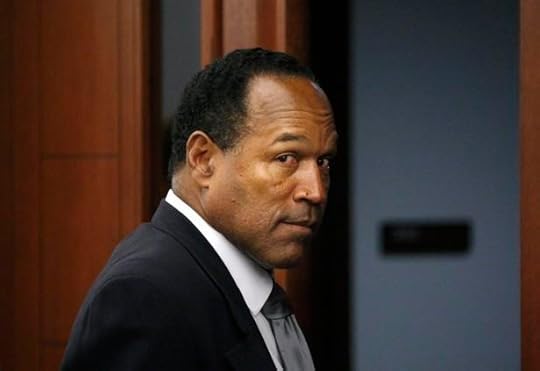
The Los Angeles Police Department is conducting forensic tests on a knife reportedly found on O.J. Simpson’s former property for possible ties to the 1994 murders of Nicole Brown Simpson and Ronald Goldman, police officials said Friday.
Although some details remain unclear, TMZ first reported that a construction worker discovered the buried knife on the property of Simpson’s former Brentwood estate “some years ago.” Simpson’s former house was razed in 1998 by new owners. The worker then reportedly walked across the street and handed it to an unidentified LAPD officer, who was working as an extra on a movie set nearby—an apparently common occurrence for off-duty LAPD officers.
The officer took the knife, then kept it in his possession without turning it over to the team investigating the Simpson and Goldman murders, Andy Neiman, a Los Angeles police captain, said at a Friday news conference. LAPD cases remain open until a suspect is convicted. The officer revealed the knife’s existence to other LAPD officers sometime this year, reportedly as he neared retirement.
“I was quite shocked,” Neiman said. He refused to identify the officer or the construction worker who found the knife, citing an ongoing investigation. Neiman ruled out administrative sanctions because the officer is now retired, but told reporters the department’s Robbery Homicide Division will look into possible criminal charges.
Simpson’s televised trial for the two murders gripped the nation in 1995, turning almost every participant into a household name and providing fodder for countless books, documentaries, and dramatizations. A FX miniseries on the courtroom saga, American Crime Story: The People vs. O.J. Simpson, debuted to critical acclaim last month.
The missing murder weapon haunted investigators before and after the trial, leading to countless false leads about its fate. Over time, it acquired a semi-mythical status. When the Brentwood estate’s new owners razed the house in 1998, a construction worker joked in an interview with the Los Angeles Times, “We haven’t found the knife yet.”
It’s still unclear whether the knife, whose existence was revealed Friday, is connected to the case in any way. Still, since Simpson, a former NFL star, was already acquitted of the murders in 1995, double jeopardy would protect him from another trial. He is currently serving a 33-year prison sentence in Nevada for his role in the 2007 armed robbery of a Las Vegas sports-memorabilia dealer. He becomes eligible for parole in October 2017.

Atlantic Monthly Contributors's Blog
- Atlantic Monthly Contributors's profile
- 1 follower



